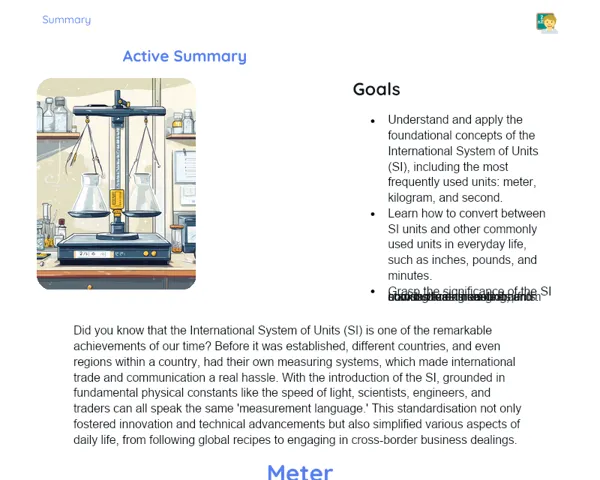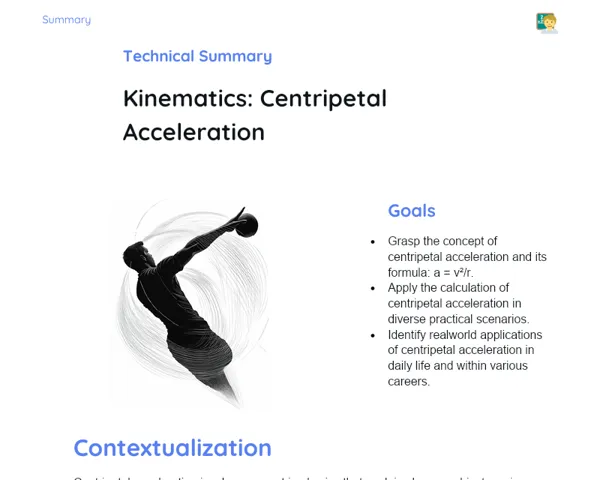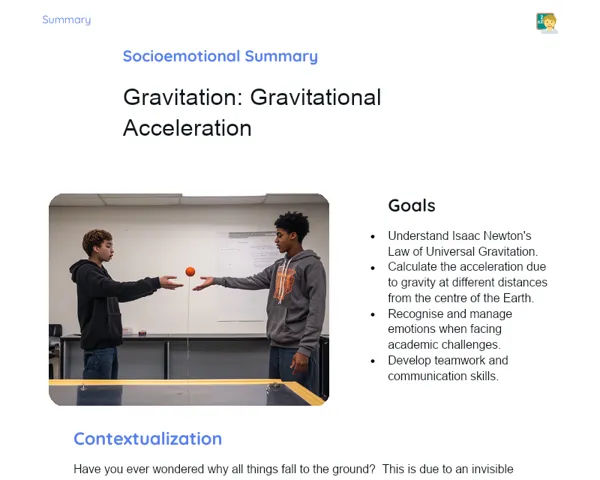Summary Tradisional | Simple Harmonic Motion: Mechanical Energy
Contextualization
Simple Harmonic Motion (SHM) is a key type of oscillatory motion in physics, seen in various physical systems and everyday applications. For instance, SHM can be noticed in the swinging of a pendulum, the vibrations of atoms in molecules, and in systems like springs and weights. This kind of motion is marked by periodic movements around an equilibrium position, where restoring forces, like the elastic force in a spring, aim to return the system to its original spot.
Grasping SHM is vital in numerous areas of physics and engineering since it plays a role in practical systems such as pendulum clocks, car suspension systems, and even musical instruments. One significant feature in the context of SHM is the conservation of mechanical energy, which includes the total of kinetic energy and potential energy in the system. Examining SHM helps learners comprehend how energy shifts between its different forms during motion, with no overall energy loss in a perfect system.
To Remember!
Mechanical Energy Concept in SHM
Mechanical energy in a Simple Harmonic Motion (SHM) system refers to the combined kinetic energy and potential energy of the setup. In an ideal SHM scenario, where no dissipative forces like friction are present, the total mechanical energy of the system stays constant over time. This indicates that the total mechanical energy is preserved, continually changing between kinetic energy and potential energy during the oscillatory action.
Kinetic energy (Ek) represents the energy linked to the object's motion and reaches its peak as the object crosses the equilibrium position, where the speed is at its highest. Conversely, potential energy (Ep) is the energy stored based on the object's position relative to the equilibrium point and hits its maximum at the extremes of the oscillation, where the spring is most deformed or the pendulum is most displaced.
Comprehending energy conservation in SHM is foundational for analyzing and forecasting the system's behavior. While tackling SHM problems, the conservation of energy equation is commonly used, relating kinetic and potential energy at various stages of the motion to compute quantities such as speed and deformation.
-
Mechanical energy is the combination of kinetic energy and potential energy.
-
In an ideal SHM, total mechanical energy is conserved.
-
Kinetic energy peaks at the equilibrium position, while potential energy is highest at the oscillation extremes.
Kinetic and Potential Energy
Kinetic energy (Ek) in SHM is expressed by the formula Ek = (1/2)mv², where m is the object's mass and v is its velocity. This energy type is greatest when the object goes through the equilibrium position, as it has maximum speed at this juncture. As the object drifts away from the equilibrium position, its speed drops, leading to a decrease in kinetic energy.
Potential energy (Ep), in turn, is captured due to the object's placement relative to its equilibrium state. In a spring system, potential energy is calculated with the formula Ep = (1/2)kx², where k denotes the spring constant and x signifies the deformation of the spring relative to the equilibrium position. Potential energy is maximized at the extremes of the oscillation, where deformation is at its peak.
The transition between kinetic energy and potential energy in SHM is smooth. When kinetic energy diminishes, potential energy swells, and vice versa. This shift showcases energy conservation in a closed system, where total energy remains constant yet transforms between the two types.
-
Kinetic energy is highest at the equilibrium position and calculated using Ek = (1/2)mv².
-
Potential energy is maximized at oscillation extremes and calculated using Ep = (1/2)kx².
-
Kinetic energy and potential energy continually interchange in SHM.
Energy Conservation
Energy conservation is a fundamental principle in physics stating that the total energy of an isolated system remains unchanged over time. In terms of Simple Harmonic Motion (SHM), this implies the sum of the kinetic and potential energy is always constant, as long as there are no dissipative forces like friction affecting the system.
In SHM, kinetic energy and potential energy constantly convert into one another. When the object is at the equilibrium position, all mechanical energy is in the form of kinetic energy. As the object moves away from the equilibrium point, kinetic energy diminishes and transforms into potential energy. At the extremes of the oscillation, all mechanical energy converts into potential energy.
The conservation of energy equation for SHM is represented as Ek + Ep = constant. This equation is instrumental in resolving problems tied to speed, position, and energy at different points in the motion. By applying energy conservation, one can predict the system's behavior and conduct accurate calculations without needing to know every detail of the movement.
-
Energy conservation asserts that total energy in an isolated system remains constant.
-
In SHM, kinetic energy and potential energy continuously interchange.
-
The conservation of energy equation (Ek + Ep = constant) is handy for solving SHM problems.
Velocity Calculation
Calculating velocity at various positions in Simple Harmonic Motion (SHM) can be executed using the principle of conservation of energy. Given that the total mechanical energy is preserved, we can utilize the conservation of energy equation (Ek + Ep = constant) to ascertain the velocity at any point during the motion.
First, we find the total mechanical energy of the system, which is the combination of kinetic energy and potential energy at a known point. Next, we select the point where we wish to determine the velocity and calculate potential energy at that point. By subtracting potential energy from total mechanical energy, we find kinetic energy at that position. Finally, we use the kinetic energy equation (Ek = (1/2)mv²) to deduce velocity.
This approach is particularly advantageous as it enables velocity calculation without needing acceleration or time. With only the system's properties (mass, spring constant, amplitude) and the chosen position, we can efficiently and straightforwardly establish the velocity.
-
Velocity can be deduced using energy conservation.
-
Find the total mechanical energy and potential energy at the chosen point.
-
Employ the kinetic energy equation (Ek = (1/2)mv²) to uncover the velocity.
Key Terms
-
Simple Harmonic Motion: A type of periodic oscillatory movement around an equilibrium position.
-
Mechanical Energy: The sum of kinetic energy and potential energy in a system.
-
Kinetic Energy: The energy tied to an object's motion, expressed as Ek = (1/2)mv².
-
Potential Energy: The energy stored due to an object's position, such as elastic energy in a spring, expressed as Ep = (1/2)kx².
-
Energy Conservation: A principle stating that total energy in an isolated system is constant.
-
Spring Constant: Represented as 'k', it measures a spring's stiffness and defines the restoring force.
-
Amplitude: The greatest distance from the equilibrium position in oscillatory motion.
-
Spring Deformation: The change in the spring's position from its equilibrium state.
-
Oscillation: A periodic back-and-forth motion around an equilibrium point.
Important Conclusions
Simple Harmonic Motion (SHM) is a core concept in physics seen in many practical systems like pendulums, springs, and musical instruments. In this lesson, we explored the importance of conserving mechanical energy, which comprises both kinetic energy and potential energy, and how these energies interchange throughout the motion. Understanding these ideas allows for the analysis and forecasting of the behavior of oscillatory systems, being essential in different fields of engineering and applied physics.
We also reviewed the crucial formulas for calculating kinetic energy (Ek = (1/2)mv²) and potential energy (Ep = (1/2)kx²), enabling us to tackle practical issues related to SHM. The notion of energy conservation in an ideal SHM was highlighted as a valuable tool for calculating speed and spring deformation at various motion stages without needing to clarify every fine detail of the movement.
This lesson stressed the relevance of SHM in real-world and technological systems, such as car suspension setups and pendulum clock mechanisms. This understanding is vital, not only for grasping fundamental physics principles but also for real-world applications that improve the efficiency and functioning of numerous devices we use in our everyday lives.
Study Tips
-
Revisit the concepts of kinetic and potential energy, ensuring you can calculate each using the correct formulas.
-
Practice addressing SHM problems by employing the conservation of energy equation to solidify your understanding and ability to apply the learned concepts.
-
Look into supplementary materials such as educational videos and interactive simulations to visualize Simple Harmonic Motion and observe how energy transforms during the motion.



